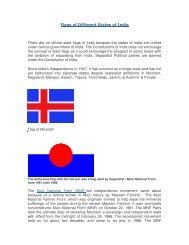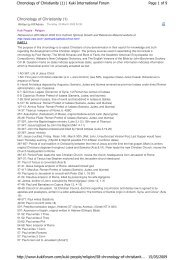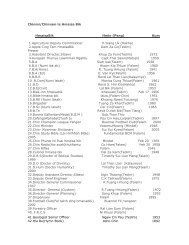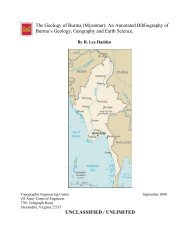abstract - Zomi Online Library
abstract - Zomi Online Library
abstract - Zomi Online Library
You also want an ePaper? Increase the reach of your titles
YUMPU automatically turns print PDFs into web optimized ePapers that Google loves.
25<br />
9.6.10 Renewal of negotiations After punishing the Kamhows, the troops returned to Fort White and Major Raikes<br />
with the Tashons opened negotiationw with the Tashons, which at first promised well, for Boimon, a<br />
Falam Chief of standing, came to the Nattan Stream to interview him. The result,<br />
however, was disappointing, as the Tashons refued to surrender the Shwe Gyo Byu and his associates, and they were<br />
not in a position to enforce the surrender of the Burman captives held by the Siyins and Kanhows, as Major Raikes then<br />
considered them able to do.<br />
9.6.11 Action At Tartan* On 4th May the last action of the expedition was fought and it merits fully<br />
description. Some new huts had been noticed on the site of Tartan, and to destroy<br />
these a party was sent from Fort White on 4th May. The following account is taken almost verbatim from the report of<br />
Captain C.H. Westmoreland, 42nd Gurkha Light Infantry. The column, consisting of 65 rifles of the 2nd Battalion Norfolk<br />
Regiment and 60 rifles of the 42nd Gurkha Light Infantry, occupied the heights above New Tartan* without opposition.<br />
The main body advanced with the intention of rushing the village, but encountered determined resistance from the Chins,<br />
who were strongly posted in two stockades.<br />
The upper stockade consisted of a log-hut, the sides and roof of which were bullet-proof. It was connected with a<br />
ravine to the east by a trench about 3 feet wide, 5 feet deep, and 20 yards long. The trench was covered with logs and<br />
planks flush with the ground. The hut itself was surrounded at a distance of 5 or 6 yards with rows of sharp-pointed<br />
stakes about 3 feet high. The second stockade was in the bed of the ravine. It consisted of a hole about 6 or 9 feet<br />
square, from which a trench ran down the ravine. Both trench and hole were covered with logs and planks and were<br />
bullet-proof. In both stockades there were a few spaces between the logs through which the Chins fired, and the only<br />
way in which they could be carried was by pulling away some of the timber.<br />
At the lower stockade, early in the action, Second-Lieutenant Michel fell mortally wounded. The troops at first<br />
endevoured to turn out the defenders of the upper stockade by firing through the openings between the logs. Before<br />
long the covered trench was noticed and pulled open and the Chins in it were shot. After accomplishing this under fire<br />
from the Chins in the lower stockade and in a the neighbouring jungle, the column retired, burning the village as it went.<br />
The Chins, who had suffered heavily, did not follow, being deterred by the loss which they had sustained and kept in<br />
check by a small covering party on the heights. In this action our loss was one officer killed and two(Captain Mayne and<br />
Surgeon LeQuesne) severely wounded and three men killed and eight wounded. Surgeon LeQuesne received the Victoria<br />
Cross for conspicuous coolness and gallantry displayed whilst dressing Lieutenant Michel‘s wound.<br />
9.6.12 Arrangements after the close The expediton now closed and the garrison of Fort White settled down for the<br />
of the expedition rains... Fort White was connected with the Kale valley by a mull-track and<br />
telegraph line. The line of communication was held by four stockades. Major<br />
Raikes remained in the hills as Political Officer and Colonel Skene in command of thre troops. The Siyin and Kanhow<br />
Chins were now living in encampments near their respective cultivations and, though beaten and driven from village<br />
sites, they maintained a dogged demeanour, showing no signs of surrender, and worrying us whenever opportunity<br />
offered.<br />
9.6.13 Events in the Yaw country Whilst General Faunce was engaged in fighting his way up in the Chin Hills, a<br />
very serious state of affairs had existed in the Yaw county, for the<br />
inhabitants, who were armed, broke out into open rebellion, and, assisted by the Southern Chins, espoused the cause of<br />
the Shwe Gyo Byu Prince...Troops, however, were quickly sent to the front, marching down the Kale valley as well as up<br />
_____________________________________________________<br />
* Note: Footnote # 2 on page 30. “The village called by us “New Tartan“ is known to the Chins as Shellum, and they give the following account<br />
of the fight. Shellum was a settlement in which about 100 persons of the Bwenman clan lived. They had built block-houses in case of surprise<br />
by the troops, who actually did not surprise them, the first intimation they received of their approach was seeing a fox-terrier which was in<br />
advance of the troops. The Chins, men, women, and children, all crowded into the block- houses, approximately 80 in numbers; they had<br />
time to get well into their positions as the troops marched past the village before they saw it. The troops then turned and attacked the block-houses.<br />
Twenty-nine Chins were killed and 11 wounded. Lyen Kam, the Bwenman Chief, was killed. There were 40 untouched persons left in the block-<br />
houses when troops retired. The Tartan Chief‘s(Dolyn) youngest brother killed and Tan Chim, another brother, wounded. Dolyn came out of it all<br />
right, but five years later died in the Myangyan jail.““







